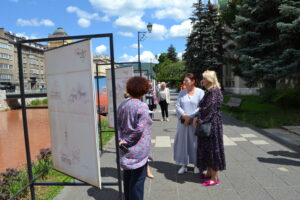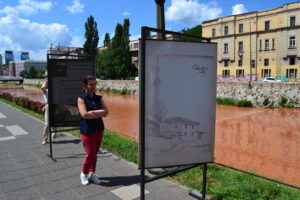The exhibition of drawings “Josip Pospišil – the Architect of Bosnia”, organized by the Federal Ministry of Culture and Sports and the Institute for the Protection of Monuments has been opened today on the promenade in Obala Maka Dizdara Street.
The exhibition was opened by Minister Sanja Vlaisavljević. “It is my pleasure to greet you all on behalf of the Federal Ministry of Culture and Sports. Namely, with the exhibition we are opening today, the Ministry actually launches a set of activities that will present a rich archive that should be available to the public and created for the public. This is a completely new approach by which the Ministry as a cultural institution opens itself to the public through numerous activities, which certainly deserve attention”.
The drawings, donated by Pospišil’s daughter to the Institute for the Protection of Monuments, were exhibited for the first time last year, within the “European Heritage Days 2022”. However, considering the huge contribution of the architect Pospišil to our community, the Ministry and the Institute decided to organize an independent exhibition of his drawings for a wider audience. The authors of the exhibition Amra Hadžihasanović, Ornela Rezinović, Azra Lojo Hajro from the Institute for the Protection of Monuments managed to bring this extremely valuable creative work of Josip Pospišil to the eyes of the public.
Nina Ugljen Ademović, a prominent architect from Bosnia and Herzegovina, spoke about Josip Pospišil, a born Czech, who already had an enviable career as a successful architect in European cities, when he continued his professional development in a different atmosphere by getting married to a Bosnian and moving to Bosnia. “This Promenade, the venue of the exhibition, was inherited from the period in which the architect Josip Pospišil worked in Sarajevo. Today it represents a public space of exceptional ambient value, where the memory of the place has been cultivated. Today, when we talk about Pospišil’s work from a respectable distance in time, we understand his process of critical reflection on the traditional form and method of construction, which served as a basis for adjusting to the contemporary context, while finding a link with European modernity.”
Josip Pospišil left an indelible mark not only on the architectural heritage, but also on the cultural history of Sarajevo and Bosnia from the beginning of the twentieth century.
His creative work reached its peak in Sarajevo, where he ended his career and his life, leaving behind a wonderfully rich work.
Although his architectural expression followed Art Nouveau, which was the ruling style in Europe in those years, Pospišil expressed a strong interest in Bosnian architectural heritage as soon as he set his eyes on Bosnia. He and Josip Vancaš, also an architect, were the main supporters of the “Bosnian Accord”, trying to find their contemporary architectural expression by searching for autochthonous and original solutions of the traditional architectural heritage of Bosnia and Herzegovina.
His most significant architectural works were created in this style, such as the Musafia Palace, Solomon Palace and the Radnik Pharmacy Building, as well as the recently renovated Music Pavilion in Sarajevo.
However, it is not well known that the Sarajevo Sebilj Fountain, one of the most significant symbols of the City of Sarajevo, was designed by Josip Pospišil.
Although the towns of Jajce, Travnik, Visoko and Kiseljak are presented on these drawings, the largest number of works still refer to Sarajevo, to which Josip Pospišil devoted the most of his time and space. His concern for the preservation of the personality of the Old Town of Sarajevo (Baščaršija) is of inestimable importance for culture.
These, undoubtedly, artistically significant drawings have not only cultural and artistic value, but also exceptional documentary value. Therefore, it is no coincidence that this architect, who spent only ten years in Sarajevo with Mula Mustafa Bašeskija, is considered one of the most important chroniclers who, unlike Bašeskija, used drawings, stated the representatives of the Institute for the Protection of Monuments.
The duo Emina Džanović from the Mostar Symphony Orchestra (violin) and Nejla Komar (cello) performed in the musical part of the programme.
The drawings will be displayed in front of the Ministry building to the interested citizens until 18 August 2023.

















